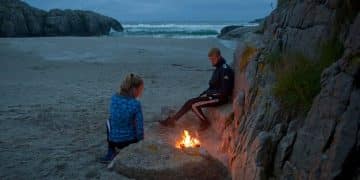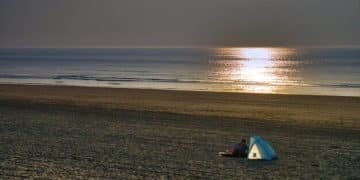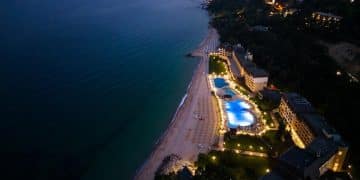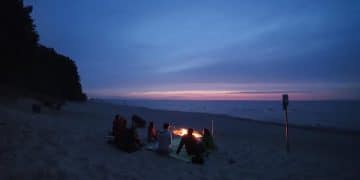Beach Bonfire Safety 2025: Regulations and Best Practices
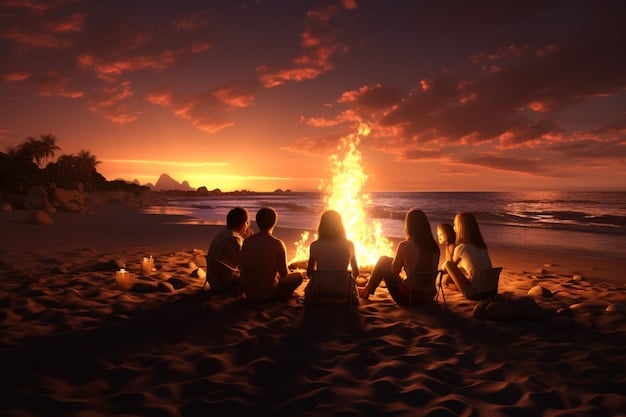
Beach bonfire safety in 2025 requires understanding local US regulations, employing best practices for fire management, and ensuring environmental protection to enjoy a safe and responsible beach experience.
Planning a beach bonfire? That sounds like a great idea! Before you light up the night, it’s crucial to understand **beach bonfire safety regulations and best practices for 2025** to ensure a fun and safe experience for everyone.
Beach bonfire regulations across the US
Each state and sometimes even individual counties and cities have their own specific rules about beach bonfires. Ignoring these regulations can lead to fines or worse.
Getting familiar with these rules will ensure compliance and prevent you from unintentionally jeopardizing your fun.
State and local ordinances overview
Many states have varying regulations on open fires on beaches. Florida, for example, requires permits in many coastal areas. California has specific rules about the time of year when bonfires are allowed, often restricting them during high fire-risk seasons. Let’s take a look at general areas of concern.
- Permit requirements: Some beaches require permits for bonfires. Check with the local authorities to secure the permit well in advance.
- Fire size and container regulations: Many regulations limit the size of the fire and require it to be contained in a designated fire pit or ring.
- Time restrictions: Some beaches only allow bonfires during specific hours, often ending before midnight.
Keep in mind these rules might be different depending on which beach you visit.
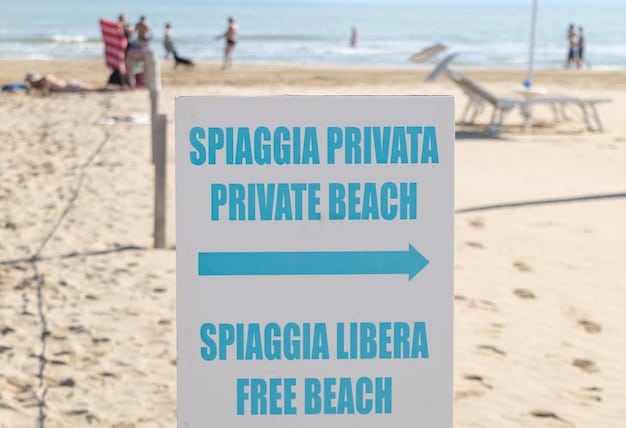
How to find specific rules
Finding the exact rules for your chosen beach requires a bit of research, but it’s well worth the effort.
Here are the main places to check.
- Local government websites: City and county websites often have detailed information on beach regulations, including those for bonfires.
- Park ranger stations: Contacting the park ranger station near the beach can provide comprehensive information about current regulations.
- Online forums and social media groups: Local community forums or beach-related social media groups can offer insights and updates from frequent beachgoers.
Confirming the rules before your trip can save you from facing unexpected problems later.
Understanding the local regulations helps ensure that your beach bonfire adheres to all legal requirements and contributes to the safety and preservation of the coastal environment.
Essential safety equipment for beach bonfires
Having the necessary safety equipment on hand is critical for preventing accidents and handling emergencies during a beach bonfire. Make sure you have these items.
Proper equipment ensures a safer and more enjoyable experience for everyone involved.
Fire containment
Containing your fire is not only a regulation on many beaches but also a crucial safety measure.
It will prevent the fire from spreading.
- Portable fire pits: Using a portable fire pit can ensure that the fire is contained and prevent damage to the sand.
- Fire rings: If the beach provides fire rings, use them. They are designed to safely contain beach fires.
- Clearance area: Clear a 10-foot radius around the fire pit of any flammable materials, such as dry grass or beach blankets.
Choosing the right method for containing your fire helps control the fire and protects the surrounding environment.
Water and sand
Having water and sand nearby helps extinguish your bonfire quickly and easily. These resources can be used in various fire-related emergencies.
They’re also essential tools for safely extinguishing the fire when it’s time to leave the beach.
- Buckets of water: Keep several buckets filled with water close to the fire. These can be used to douse flames that get too high or to completely extinguish the fire.
- Shovels for sand: Shovels should be used to cover the fire with sand. Sand smothers the fire and helps to cool down the embers.
- Fire extinguisher: A fire extinguisher can be beneficial to have for more significant fire emergencies. Make sure it is appropriate for the types of materials you are burning.
By having water and sand readily available, you’ll be well-prepared for managing the fire and dealing with any unexpected flare-ups, ensuring the safety of everyone nearby.
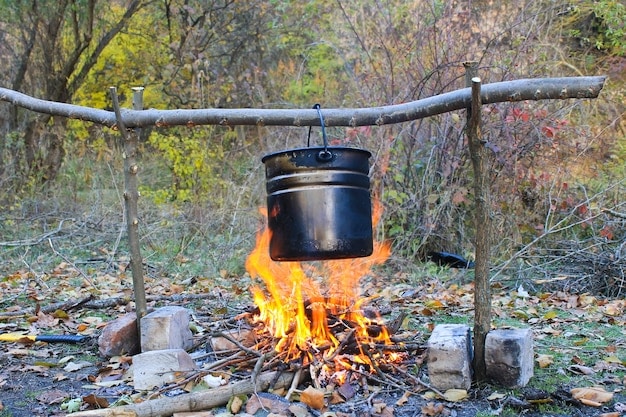
Best practices for building and maintaining a beach bonfire
Building and maintaining a beach bonfire requires careful attention to detail. These aren’t skills everyone has, but luckily, it’s easy to teach.
Following best practices ensures the fire is safe, manageable, and enjoyable for everyone.
Safe fuel choices
The type of fuel you use in a beach bonfire significantly impacts its safety and environmental impact.
Choosing the right fuel can minimize the risk of toxic fumes and uncontrolled flames.
- Dry, seasoned wood: Use only dry, seasoned wood. Wet or unseasoned wood produces excessive smoke and is harder to burn.
- Avoid treated wood: Never burn treated wood (e.g., plywood, painted wood), as it releases toxic chemicals into the air.
- No trash or plastics: Do not burn trash, plastics, or other synthetic materials, as these can produce harmful fumes and leave residue.
The best fuel ensures a clean and safe burn, contributing to the health of both people and the environment.
Supervision and tending of the fire
Keeping a close watch on your beach bonfire is essential to prevent accidents and ensure it burns safely. It also protects others from harm.
A responsible approach maintains a manageable and enjoyable fire.
- Continuous supervision: Always have someone watching the fire. Never leave the bonfire unattended.
- Manage flame height: Keep the flames at a reasonable height, adding wood gradually to avoid sudden flare-ups.
- Keep a safe distance: Ensure that everyone, especially children, maintains a safe distance from the fire.
Attentive supervision helps maintain a safe bonfire, preventing accidents and allowing everyone to enjoy the warmth and ambiance responsibly.
By implementing these best practices, you’ll create a bonfire that’s not only enjoyable but also safe and environmentally responsible.
Environmental considerations for beach bonfires
Beach bonfires can have an impact on the environment if not handled properly. It’s important to consider wildlife.
Taking proactive steps minimizes your fire’s ecological footprint and protects the natural beauty of the beach.
Leave no trace principles
Adhering to the “Leave No Trace” principles is vital for preserving the beach environment. It keeps the beach as natural and pristine as possible.
Following these guidelines helps maintain the beach’s integrity for future generations.
- Pack out everything you pack in: Remove all trash, including food wrappers, bottles, and any other items you brought to the beach.
- Dispose of ashes properly: Ensure ashes are completely cooled, then pack them out in a container. Never bury ashes on the beach, as they can contain harmful chemicals.
- Avoid disturbing dunes and vegetation: Stay away from dune areas and avoid trampling vegetation, as these are essential for preventing erosion and providing habitat.
Adhering to these principles helps you make the most of the beach while doing the least damage.
Respect for wildlife
Beaches are home to various forms of wildlife. Minimizing disturbance keeps the lives of these animals on the beach.
Respecting their habitat helps to maintain the ecological balance of the coastal environment.
- Avoid nesting areas: Be aware of nesting areas for birds and turtles, especially during breeding seasons. Keep a respectful distance to avoid disturbing them.
- Reduce light pollution: Use minimal lighting and avoid bright lights that can disorient nocturnal animals, such as sea turtles.
- Keep food secure: Store food in airtight containers to prevent attracting scavenging animals like seagulls and raccoons.
When visitors are respectful of wildlife, it helps to preserve the local animal population.
Considering the environmental impact helps everyone enjoy the beaches for years to come.
Understanding liability and insurance for beach bonfires
Understanding your liability and insurance coverage is important when hosting a beach bonfire. Be sure you’re covered in case something happens.
Knowing your responsibilities protects you and your guests from potential financial and legal repercussions.
Personal liability
As the host of a beach bonfire, you are responsible for the safety of your guests and the surrounding environment. It’s better to be safe than sorry.
Understanding the scope of your personal liability can help you take necessary precautions. If you do that, legal issues should be less likely.
- Injuries: You may be liable for injuries sustained by guests or others as a result of the bonfire, especially if negligence is involved.
- Property damage: You are responsible for any property damage caused by the bonfire, such as damage to beach facilities or nearby private property.
- Environmental damage: You may be liable for any environmental damage caused by the bonfire, such as starting a wildfire or contaminating the beach with ashes or debris.
If you’re responsible, take steps to avoid injury or other issues.
Homeowner’s or renter’s insurance
Homeowner’s or renter’s insurance may provide some coverage for incidents that occur during a beach bonfire. It’s important to review your policy. However, insurance may not cover an incident, so it’s important to do your due diligence.
Consider these things:
- Coverage limits: Understand the coverage limits of your insurance policy and whether they are sufficient to cover potential liabilities.
- Exclusions: Be aware of any exclusions in your policy that may apply to beach bonfires, such as intentional acts or violations of local regulations.
- Additional coverage: Consider purchasing additional liability coverage if you frequently host events or if your existing policy is inadequate.
Understanding liability and insurance ensures you are prepared for any potential incidents, protecting your financial well-being and allowing you to host bonfires with peace of mind.
Alternative options for beach gatherings
If the regulations or logistics of having a beach bonfire seem too complicated or restrictive, there are several alternative options for enjoying a beach gathering.
Exploring these alternatives allows you to enjoy your beach time without the complexities of managing a fire.
Portable grills and cookouts
Using a portable grill for a beach cookout can be a great way to enjoy food and company without the need for an open fire.
Grills offer a controlled cooking environment and often have fewer restrictions compared to bonfires.
- Propane grills: Propane grills are easy to use, offer consistent heat, and are allowed on many beaches.
- Charcoal grills: Charcoal grills provide a traditional barbecue flavor but require more attention and proper disposal of ashes.
- Electric grills: Electric grills are convenient if the beach has access to power outlets, offering a clean and easy cooking experience.
You can still cook burgers and enjoy the beach with these alternatives.
| Key Topic | Brief Description |
|---|---|
| ⚠️Regulations | Understand and adhere to all local bonfire regulations. |
| 🔥Equipment | Always have safety equipment such as water and a shovel available. |
| 🗑️Environment | Leave no trace; pack out everything you bring to the beach. |
Frequently Asked Questions About Beach Bonfire Safety
▼
Dry, seasoned wood is the best option because it burns cleaner and produces less smoke. Avoid treated wood, as it contains toxic chemicals that can be harmful when burned.
▼
Allow the ashes to cool completely, then pack them out in a container. Do not bury them on the beach, as they can contain harmful chemicals. Always follow local regulations for ash disposal.
▼
Maintain a safe distance of at least 10 feet from other people and flammable materials. Ensure there is enough space to prevent the fire from spreading and to keep everyone safe.
▼
Many beaches require a permit for bonfires. Check with the local authorities or park ranger station to determine if a permit is needed and how to obtain one. This is especially important for larger gatherings.
▼
Violating regulations can lead to fines, legal liabilities, and even being asked to leave the beach. It’s essential to understand and follow all local rules to avoid these consequences and ensure a safe and responsible bonfire.
Conclusion
By following these **beach bonfire safety regulations and best practices for 2025**, you can ensure a memorable and safe experience. Always check local guidelines, equip yourself with the necessary safety gear, and respect the environment. With proper planning, your beach bonfire will be a highlight of your summer.
